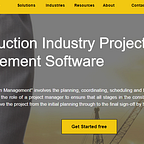Creating a risk assessment method statement
A risk method statement is a document that lists out in detail the way a work task or process is to be completed as part of the wider project management. As construction sites are dangerous, the method statement should outline the hazards involved and include a step by step guide on how to do the job safely.
Because no matter how you look at it, there is always an accident waiting to happen. Under government legislation employers are legally obligated to mitigate risks on work sites. by creating Risk Assessment Method Statements (RAMS) for every workplace.
Risk assessments are necessary to keep everyone safe on a work site. They identify risks and how to minimize and eliminate them. The purpose of method statements is to control specific health and safety risks (for example, working at height). Safety method statements usually contain a risk assessment.
Together risk assessments and method statements are referred to as RAMS. RAMS may be required by a third party to demonstrate all due care is taken under government legislation. It is a requirement more common than ever for subcontractors to submit a RAMS before starting a project.
Creating a risk assessment
A risk assessment is when you systematically examine a task, environment, process or job to identify significant hazards before starting work on a project. This allows you to identify any risks of harm to workers and put control measures in place. It is an employer’s responsibility to carry out risk assessments in accordance with relevant legislation to ensure the health and safety of employees.
Carry out separate risk assessments for all tasks and processes on all work sites relevant to your organization before employees start work. Review them on a regular basis. How often depends on the nature of the work site. In construction, you may need to do this every day.
There are 8 steps to completing a workplace risk assessment.
Identify the hazards
Hazards are situations, processes and environmental conditions with the potential to cause harm. Focus on hazards that cause significant harm such as trips and slip risks from working at height. To identify hazards, consult:
- workers
- accident, sickness and near miss records
- safety data sheets
- workplace inspections
- instruction manuals.
Who is at risk?
Consider who the risk impacts. Make sure you take into account those who are disabled, young and inexperienced, temporary staff, and all office and construction site workers.
Identify control measures already in place
Look at the processes already in place for controlling risks in the workplace. Analyze existing control measures. Are they adequate? To evaluate the risk severity and likelihood of it occurring, complete a risk ranking.
Evaluate the risk
How likely is a risk to harm someone? Remember, a risk is a hazard that can cause harm; for example, risk = likelihood x severity based on:
- likelihood:
1. highly unlikely
2. unlikely
3. possible
4. probable
5. certain.
- then — consider the severity of an injury if the risk of a hazard occurs:
1. scratch (trivial)
2. cut (minor injury)
3. fracture (major injury)
4. amputation (major injury)
5. death (death).
Decide and implement new controls
If there are not adequate control measure to mitigate risks, decide what new procedures you need and implement them. Control measures are what your organization will do to reduce a risk and its impact. Work through the hierarchy of controls to help make decisions:
- eliminate
- substitute
- physical controls
- administrative controls
- information
- personal protection equipment.
Make controls simple and easy to follow and understand for workers. Monitor control measures to make sure they are effective.
Record the assessment
Keep records of risk assessments. You may need them if you get inspected or an accident happens.
Monitor and review
Monitor and review the control measures you put in place. You need to know if they are effective. You may need to make adjustments to get the level of desired control to mitigate risks.
Inform
You are legally obligated to inform everyone affected by any hazards and any new control measures put in place.
Creating a method statement
You require a safety method statement for all jobs or tasks that have some measure of risk. A subcontractor may need to as part of a tender/quote or before starting work. Safety method statements are a commitment to the health and safety of employees. They influence:
· selecting capable staff, and good quality equipment and materials
· workplace processes and procedures
· the design and delivery of goods and services.
Implement safety method statements and monitor them regularly. Make safety statements available to staff and any other relevant stakeholders. These show a workplace has identified hazards and assessed the risks, and have control measures in place to eliminate or control them.
Keep copies of all method statements. You may need them one day.
While the benefits of complying with rules and regulations reduce the incidence of work site accidents, it also improves the quality of work and reduces costs during a construction project.
Still using spreadsheets and Word documents to complete your rams? Digital software makes preparing a free RAMS simple and quick.
Tags:
